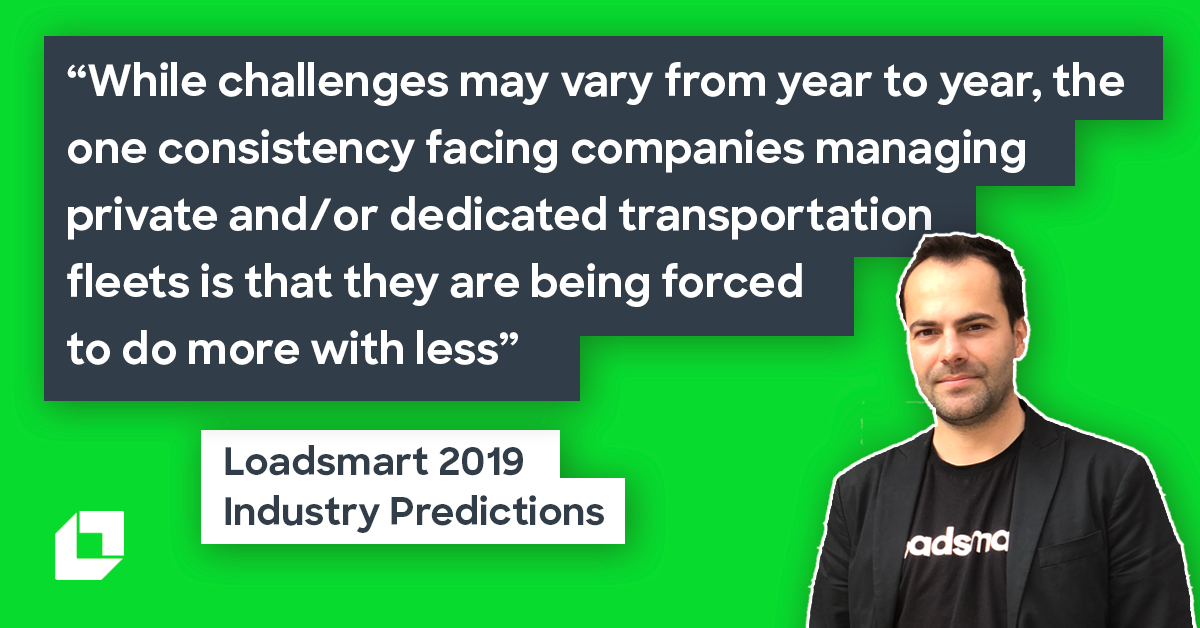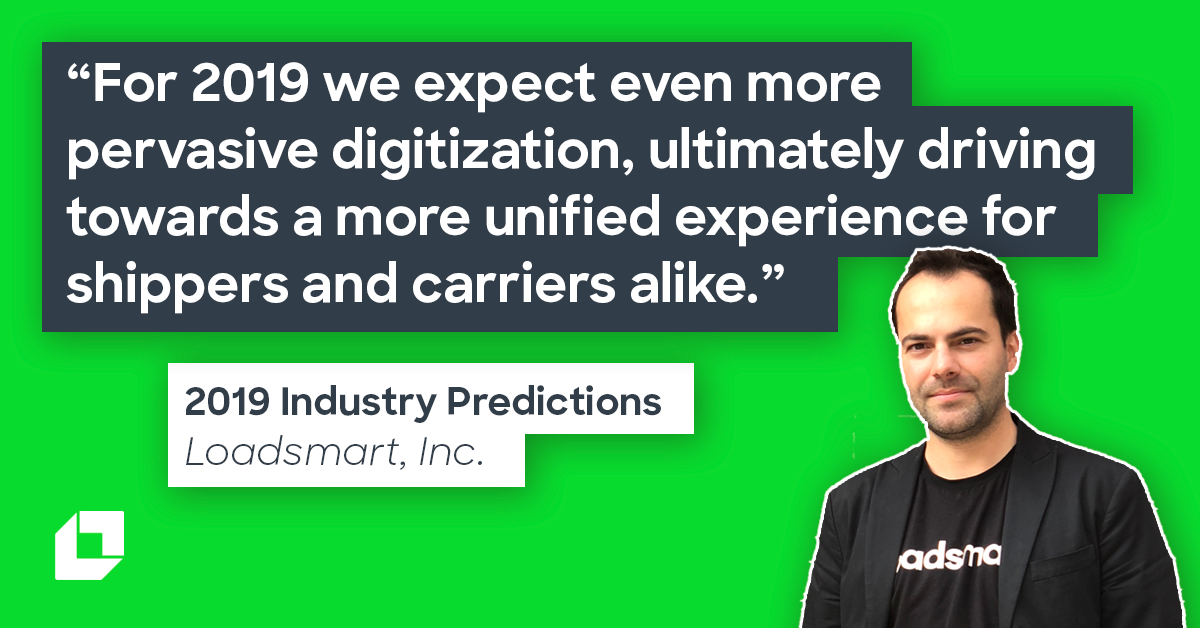Share this
Our freight brokerage predictions for 2019
by admin
While the challenges facing the trucking industry may vary from year to year, the one consistency is that companies managing private and/or dedicated transportation fleets are being forced to do more with less. Following the ever-increasing need to improve efficiencies, the digitization of the supply chain proved to have a substantial impact on the efficiency and flow of freight operations in 2018.

Felipe Capella, chief product officer, Loadsmart
As we review our predictions from last year, it’s safe to say most of them held true. Data sharing and open access, the onset of APIs, instant pricing + booking, and technologies such as machine learning have made all the difference in getting the most out of finite transportation resources.
For 2019 we expect even more pervasive digitization than last year, ultimately driving towards a more unified experience for shippers and carriers alike.
- Shippers Will Improve DC Processes
Having witnessed initial digitization successes, shippers will recognize that there is more to gain from automating and leveraging data for the benefit of the distribution center. This includes the desire to dramatically reduce truck waiting times, automating and increasing appointment efficiency, and coordinating arrivals and departures better. It will be all about enabling shippers to bring technology further inside the supply chain operations. Furthermore, as contract rates continue to slide and the pendulum is swinging back in favor of the shippers, 2018 peak prices remain on everyone’s mind. Shippers drive to reduce risk across the supply chain and embrace innovation will open them up to greater collaboration within the industry. Carriers, shippers and 3PLS will work together to integrate operations and data to provide more context, which in turn will help shippers recognize patterns and enable them to balance their risk better. - Carriers Open Up for API Integrations
Carriers will follow shippers in their pursuit for APIs and embrace similar openness. Fleet operators will share data for mutual industry benefit leading to a more efficient service to shippers. Software will also become more open to utilization across different platforms. - New Economic Models for Contracted Capacity
The traditional model no longer works. The promise of a 12-month fixed rate for each lane leads to wrong incentives and often sees shippers missing budgets with rates that are out of touch with the market and constant contract renegotiation. In 2019, brokers and carriers will collaborate better and begin adopting modern pricing tactics very similar to those derived from the financial and airline industries, which are more advanced when it comes to pricing and risk allocation.With these advanced pricing and risk models, shippers will be able to find ready access to capacity with rates that are dynamic and in line with market conditions.
Felipe Capella, chief product officer, Loadsmart
- Full Service: door-to-door integrations
Just as consolidation will happen across brokers, the big players are looking to offer a unified experience for their customer across all modes. We will start seeing integrated providers offering door-to-door supply chain solutions across modes with fewer intermediaries and unified visibility.
What are your thoughts?
Share this
- Loadsmart Blog (159)
- Blog (121)
- Shipper (106)
- Market Trends (99)
- Enterprise Shipper (69)
- Carrier (66)
- News (62)
- Data Insights (51)
- Thought Leadership (45)
- Warehouse (41)
- SMB Shipper (38)
- Our Partners (34)
- ShipperGuide TMS (31)
- Opendock (30)
- Product Updates (29)
- Mode Optimization (25)
- Loadsmart (23)
- Mid-Market Shipper (18)
- Case Study (17)
- Brokerage Services (15)
- Managed Transportation (11)
- Video (9)
- Award (7)
- FreightIntel AI (5)
- Instant Execution (4)
- Asset (3)
- Food and Beverage (3)
- Freight Management (3)
- Logistics Solutions (3)
- YMS (3)
- eBook (3)
- 4PL (2)
- International (2)
- NavTrac (2)
- Podcast (2)
- UK (2)
- Yard Management System (2)
- Cold Storage (1)
- Faces of Loadsmart (1)
- Paper Packaging (1)
- Retail (1)
- Security (1)
- Transportation Management System (1)
- November 2025 (1)
- October 2025 (2)
- September 2025 (1)
- August 2025 (1)
- July 2025 (1)
- June 2025 (1)
- May 2025 (7)
- April 2025 (6)
- March 2025 (3)
- February 2025 (10)
- January 2025 (4)
- December 2024 (4)
- November 2024 (5)
- October 2024 (11)
- September 2024 (11)
- August 2024 (5)
- July 2024 (5)
- June 2024 (9)
- May 2024 (7)
- April 2024 (6)
- March 2024 (2)
- February 2024 (2)
- January 2024 (5)
- December 2023 (6)
- November 2023 (2)
- October 2023 (12)
- September 2023 (5)
- August 2023 (3)
- July 2023 (4)
- June 2023 (10)
- May 2023 (5)
- April 2023 (5)
- March 2023 (7)
- February 2023 (5)
- January 2023 (7)
- December 2022 (4)
- November 2022 (13)
- October 2022 (4)
- September 2022 (7)
- August 2022 (11)
- July 2022 (6)
- June 2022 (5)
- May 2022 (2)
- April 2022 (4)
- March 2022 (6)
- February 2022 (7)
- January 2022 (9)
- December 2021 (3)
- November 2021 (5)
- October 2021 (7)
- September 2021 (2)
- August 2021 (2)
- July 2021 (4)
- June 2021 (6)
- May 2021 (6)
- April 2021 (5)
- March 2021 (8)
- February 2021 (3)
- January 2021 (3)
- December 2020 (7)
- November 2020 (9)
- October 2020 (7)
- September 2020 (6)
- August 2020 (10)
- July 2020 (8)
- June 2020 (3)
- May 2020 (1)
- April 2020 (2)
- March 2020 (2)
- February 2020 (1)
- January 2020 (1)
- November 2019 (2)
- October 2019 (1)
- September 2019 (2)
- August 2019 (3)
- July 2019 (2)
- June 2019 (2)
- May 2019 (3)
- March 2019 (1)
- February 2019 (3)
- December 2018 (1)
- November 2018 (2)
- October 2018 (1)
- September 2018 (2)
- August 2018 (1)
- July 2018 (1)
- June 2018 (3)
- May 2018 (4)
- April 2018 (1)
- February 2018 (1)
- January 2018 (4)
- November 2017 (1)
- October 2017 (2)
- June 2017 (1)
- May 2017 (2)
- April 2017 (1)
- February 2017 (1)
- January 2017 (2)
- October 2016 (1)
- August 2016 (1)
- July 2016 (2)
- June 2016 (1)
- March 2016 (1)
- January 2016 (1)
- December 2015 (3)
- November 2015 (2)
- October 2015 (6)
- July 2015 (1)
- June 2015 (1)
- April 2015 (2)
- March 2015 (13)
- February 2015 (17)
- January 2015 (15)
- December 2014 (35)
- November 2014 (26)
- October 2014 (60)
- September 2014 (2)